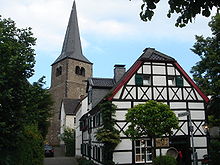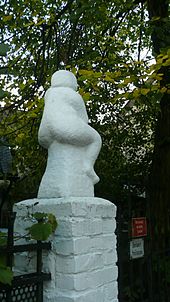Kückeshaus
Kückeshaus , formerly also Keukeshaus, Kocheshaus, Koicheshuyß or Kuychehus, is a secular building located at Eisengasse 2 / corner Schwanenstraße 12 in Hilden , Mettmann district ( North Rhine-Westphalia ). The listed half-timbered house is designed with St. Andrew's crosses in the compartments and has a half-hipped roof facing Schwanenstrasse. It was built between 1766 and 1767 as a poor house for the then Reformed Community of Hilden.
The "Kückeshaus" was built in 1766 and was added to the list of architectural monuments in Hilden on October 25, 1984 with the number 6 . Coordinates: 51 ° 10 ′ 6.3 " N , 6 ° 55 ′ 54.4" E
history
The first Kückeshaus
The first Kückeshaus stood at the end of Kirchgasse today, Eisengasse, as the kitchen house of the Fronhof of the Archbishop of Cologne. At that time Eisengasse was still called Kirchgasse. It was first mentioned in a document in 1420. In 1430 Dederich Kuychen (Dietrich Küchen) is mentioned as the feudal lord of the feudal lord residing on Haus Horst (Hilden) in the kitchen house. The first Kückeshaus was completely destroyed in a major fire in the center of Hilden in 1594. Only the vaulted cellar of the house remained, in which the traces of fire can still be seen. It is the oldest vaulted cellar in the Mettmann district.
In the opposite house there used to be the Fronhof's milk and scullery. The old house names "Bechermannsgut" (1420) and "Scheuermannsgut" (1430) pointed directly to this. Around 1350, Henken Schuyrpot (Heinrich Scheuertopf) is mentioned as a feudal man. With the Leyhaus (slate house) built around 1600 on the same site, the name reference to Fronhof disappeared.
Court court at the Kückeshaus
Archbishop Friedrich III. von Cologne enfeoffed knight Konrad von der Horst with the administration of the manor Horst in 1404. For farms lent to Haus Horst in Hilden, a court court called “Am Kückeshaus” was held next to the court court at the “Hohen Hof”.
The second chick house
The Reformed Community of Hilden bought the second kitchen house in 1752 and rented it out.
The poor house
When in the 1760s caring for the poor and needy in the Reformed Congregation proved to be a growing problem, Pastor Johann Stephan (Johannes Stephanus) Halfmann (born December 1, 1723 in Hattingen ; † May 31, 1808) came up with the idea to make the Kückeshaus available to the needy. The previous tenant Jacob Hüsgen was supposed to move out so that the house could then be converted into a poor house. However, the plans were delayed due to a lack of funds. In August 1765 the tide turned. On August 21, 1765, however, Johann Wilhelm Bongard (* around 1715 in Hilden; † July 11, 1781 in Amsterdam ) agreed not only to pay for the renovation, but also for the demolition of the previous Kückeshaus and the construction of the poor house wear. The shell was built in September 1766.
Johann Wilhelm Bongard (also Bongardt, Bungart, Bungerts) was the eleventh child of David Bongard (born April 19, 1667 in Mettmann ; † December 3, 1736 in Hilden ) and Elisabeth Klein (baptized February 5, 1674 in Mettmann; † 9. Born August 1712 in Hilden). After completing his commercial training, Johann Wilhelm Bongard went to Amsterdam as a businessman and called himself Joan Willem Bongard there. He became prosperous there. He remained childless until his death on July 16, 1781.
His older brother Theodor Bongard the Elder (baptized June 23, 1709 in Hilden; † February 6, 1759 in Solingen ) lived with his wife Anna Maria, née. Cölsch (* around 1716; † July 11, 1791 in Hilden) in Hilden am Hagdorn. They lived in the first Hagdorn house . His son, Theodor Bongard the Younger, had the "Hagdorn House" with its playful turret rebuilt between 1820 and 1830 as the first stone house in Hilden. Since March 1, 1810, he has also owned the former manor Horst . He was the heir to Johann Wilhelm Bongard and administrator of the inheritance share for the poor house.
Johann Wilhelm Bongard (Joan Willem Bongard) remained connected to Hilden. He took over the cost of building the poor house with 1200 Reichstalers and made an additional 1000 Reichstaler available, the interest of which was used to pay for the housekeeping of the poorhouse and the care of the poor by poor parents (home management). Johann Wilhelm Bongard decreed that the interest of another 500 Reichstalers should be used to pay a maid and an additional 500 Reichstaler for repairs to the poor house. He also decreed that 400 Reichstaler should be invested and that the interest should be used for the schoolmaster to teach the poor children.
The poor house was inaugurated on September 16, 1767 in the presence of the founder Johann Wilhelm Bongard. Despite its proximity to the Itterbach, the two-story building already has a cellar.
16 to 20 foster children and the poor parents lived in the poor house at the same time. A total of around seventy needy residents lived there from 1767 to 1809 and, over the years, twelve poor parents. It should be noted that the poor house was not a refuge for people unwilling to work, but that it also functioned as an old people's home, nursing home, homeless shelter and workhouse.
Without lease, the poor house was given two parcels of 3 to 4 acres of sandy farmland for use and usufruct. Different types of grain and vegetables were grown there. A poor house bill from 1772 shows that potatoes were also grown there. This is the earliest evidence of potato cultivation in Hilden. General Friedrich Gisbert Wilhelm von Romberg (1729–1809), Governor of Stettin, gave the poor house three acres of pasture land on the Juighfelde from the Fronhof property free of charge. Since this area was too small to be able to keep two dairy cows, Pastor Johann Stephan Halfmann from the Reformed Church leased an additional three acres of grassland and farmed it himself.
In the poor house there were two spinning wheels on which flax was processed.
In 1899 the poor house got a water connection.
The residential building Kückeshaus
In 1807 Pastor Johann Stephan Halfmann, to whom the poor house had always been close to his heart, retired after 57 years in Hilden. Because of the high costs, his successor Pastor Peter David Batzenschläger (baptized November 8, 1771 in Wülfrath ; † March 25, 1821 in Hilden) suggested that the poor should be fed with other families with the necessary support. The operation of the Kückeshaus as a poor house was given up in 1809 and the building was leased to Peter Vogelskamp. The church master Hackländer leased the land on behalf of his brother-in-law Wilhelm Volmer zu Dornshaus. The house and courtyard were auctioned on September 1, 1825. Wilhelm Vogelsang won the bid for 1005 Reichstalers, who declared that he had bid on behalf of Abraham Burbach. For 490 thalers, Burbach also bought the “Poor's Fight”, which belonged to the Vicariate Fund of the Reformed Community. Then the house received an extension and the door on the gable side.
In 1976 the house was in a desolate state. There was another outhouse in the yard. Until 1980, the Kückeshaus was restored by its current residents in accordance with a listed building. During excavation work, a well over 6 m deep was found.
There was initially a ceramic exhibition on the ground floor, and since 2007 there has been an art gallery run by the house owners. In 2012 the house was extensively renovated inside and out.
Individual evidence
- ↑ Time track search Hilden
- ↑ a b Christoph Schmidt: Hilden: Stefanie Breuers lives in the poor house. Rheinische Post , October 25, 2017, accessed on October 27, 2017 .
- ↑ Gerd Müller: The village of Hilden during the Reformation , In: Hildener Jahrbuch 1991 , New Series, Vol. VII, pp. 37–39, Hilden City Archives 1991.
- ↑ 1000 years Hilden, Festschrift 1985; From the citizens for the citizens , City of Hilden 1985.
- ↑ a b c Astrid Kierdorf: The poor house of the reformed community Hilden 1767-1809 (1825) , Niederbergische contributions, vol. 59, Hilden town archive, Hilden 1993.
- ↑ a b Uwe Boelken: The families of the reformed community Hilden 1649–1809 , in: Niederbergische Posts, Volume 65, Hilden City Archives, Hilden 2002.
- ^ Ernst Huckenbeck: History of the Reformed Community Hilden , Vol. II (1650–1827), pp. 193–195, Evangelical Church Community Hilden 1994.
- ^ Gerd Müller: Stadtwerke Hilden, foundation, structure and history , Stadtwerke Hilden 1984.
- ↑ Gallery "Art Shop" opens on Friday. Rheinische Post, May 3, 2014, accessed on June 21, 2019 .
- ^ Margarita Bergmann: Hilden: Journey into the past. Westdeutsche Zeitung , September 13, 2009, accessed October 20, 2016 .


